1993 CHEVROLET BLAZER ESP
[x] Cancel search: ESPPage 193 of 386
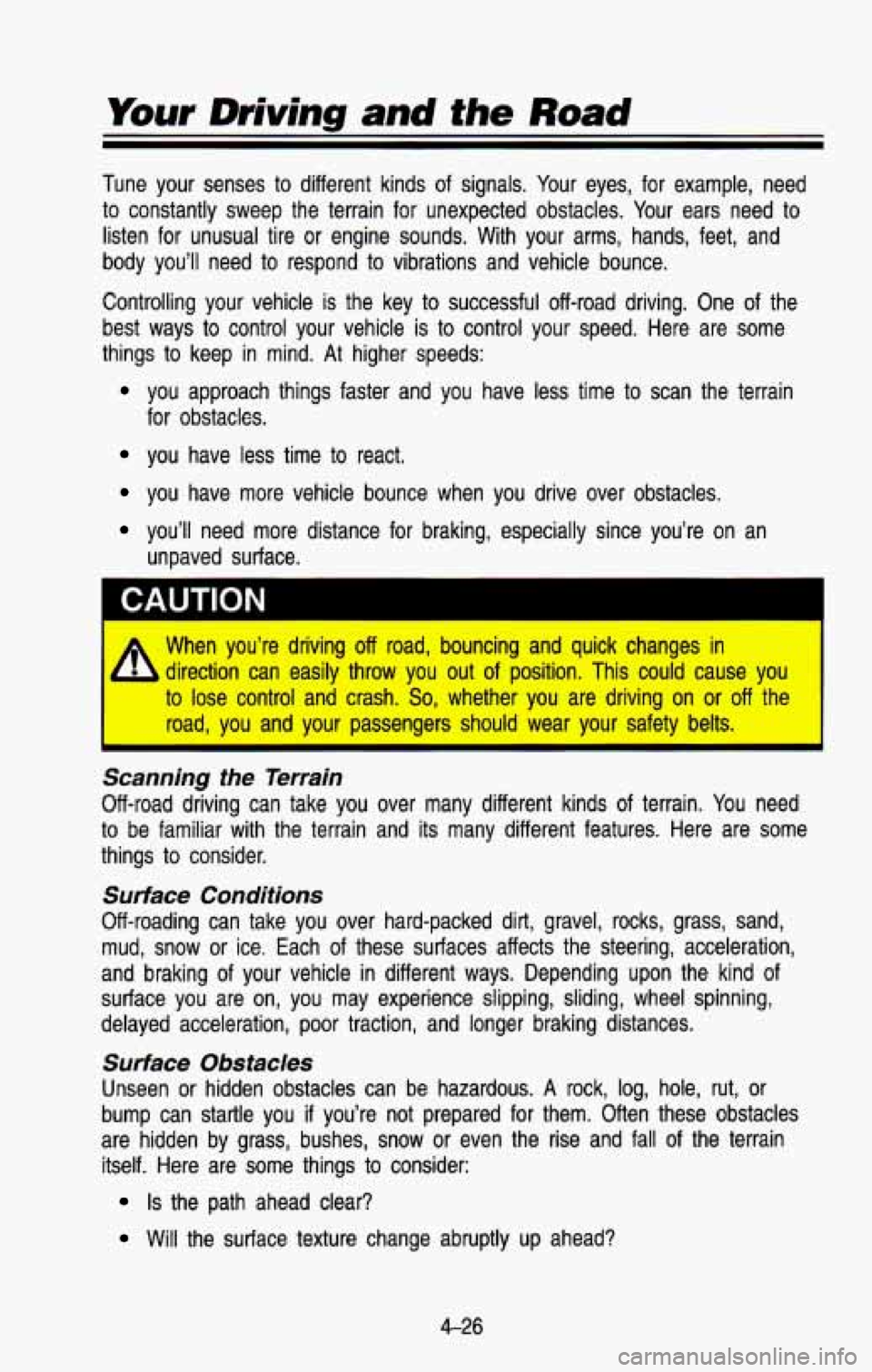
Your Driving and the Road
Tune your senses to different kinds of signals. Your eyes, for example, need
to constantly sweep the terrain for unexpected obstacles. Your ears need to
listen for unusual tire or engine sounds. With your arms, hand\
s, feet, and
body you’ll need to respond
to vibrations and vehicle bounce.
Controlling your vehicle is the key to successful off-road driving. One of the
best ways to control your vehicle
is to control your speed. Here are some
things to keep in mind.
At higher speeds:
you approach things faster and you have less time to scan the\
terrain
for obstacles.
you have less time to react.
you have more vehicle bounce when you drive over obstacles.
you’ll need more distance for braking, especially since you’\
re on an
unpaved surface.
A
When you’re driving off road, bouncing and quick changes in I
direction can easily throw you out of position. This could cause you
to lose control and crash.
So, whether you are driving on or off the
road, you and your passengers should wear your safety belts.
Scanning the Terrain
Off-road driving can take you over many different kinds of terrain. You need
to be familiar with the terrain and its many different features. Here are some
things to consider.
Surface Conditions
Off-roading can take you over hard-packed dirt, gravel, rocks, grass, sand,
mud, snow or ice. Each of these surfaces affects the steering, acceleration,
and braking of your vehicle in different ways. Depending upon the kind of
surface you are on, you may experience slipping, sliding, wheel spinning,
delayed acceleration, poor traction, and longer braking distances\
.
Surface Obstacles
Unseen or hidden obstacles can be hazardous. A rock, log, hole, rut, or
bump can startle you
if you’re not prepared for them. Often these obstacles
are hidden by grass, bushes, snow
or even the rise and fall of the terrain
itself. Here are some things to consider:
Is the path ahead clear?
Will the surface texture change abruptly up ahead?
4-26
Page 194 of 386
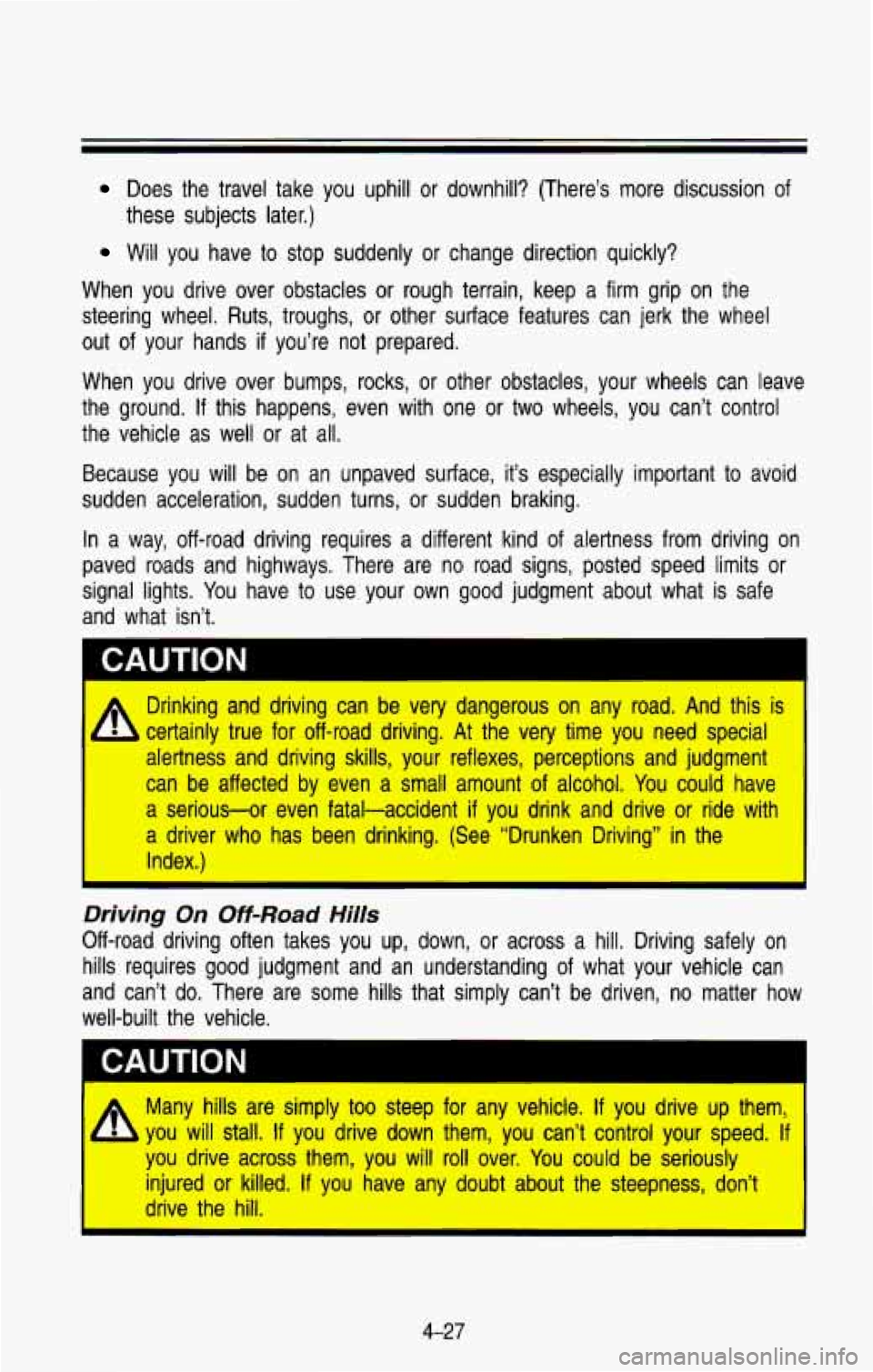
Does the travel take you uphill or downhill? (There’s more discussion of
these subjects later.)
Will you have to stop suddenly or change direction quickly?
When you drive over obstacles
or rough terrain, keep a firm grip on the
steering wheel. Ruts, troughs, or other surface features can jerk the wheel
out of your hands
if you’re not prepared.
When you drive over bumps, rocks, or other obstacles, your wheels can leave
the ground.
If this happens, even with one or two wheels, you can’t control
the vehicle as well or at all.
Because you will
be on an unpaved surface, it’s especially important to avoid
sudden acceleration, sudden turns, or sudden braking.
In a way, off-road driving requires a different kind of alertness from driving on
paved roads and highways. There are no road signs, posted spee\
d limits or
signal lights. You have to use your
own good judgment about what is safe
and what isn’t.
I CAUTION
Drinking and driving can be very dangerous on any road. And this is
- b certainly true for off-road driving. At the very time you need special
alertness and driving skills, your reflexes, perceptions and jud\
gment
can be affected by even a small amount
of alcohol. You could have
a serious-or even fatal-accident
if you drink and drive or ride with
a driver who has been drinking. (See “Drunken Driving” in the
Index.)
Driving On Oft-Road Hills
Off-road driving often takes you up, down, or across a hill. Driving safely on
hills requires good judgment and an understanding of what your vehicle can
and can’t do. There are some hills that simply can’t be driven, no matter how
well-built the vehicle.
I CAUTION
A Many hills are simply too steep for any vehicle. If you drive up them,
62 you will stall. If you drive down them, you can’t control your speed. If
you drive across them, you will roll over. You could be seriously
injured or killed.
If you have any doubt about the steepness, don’t
drive the hill.
4-27
Page 202 of 386
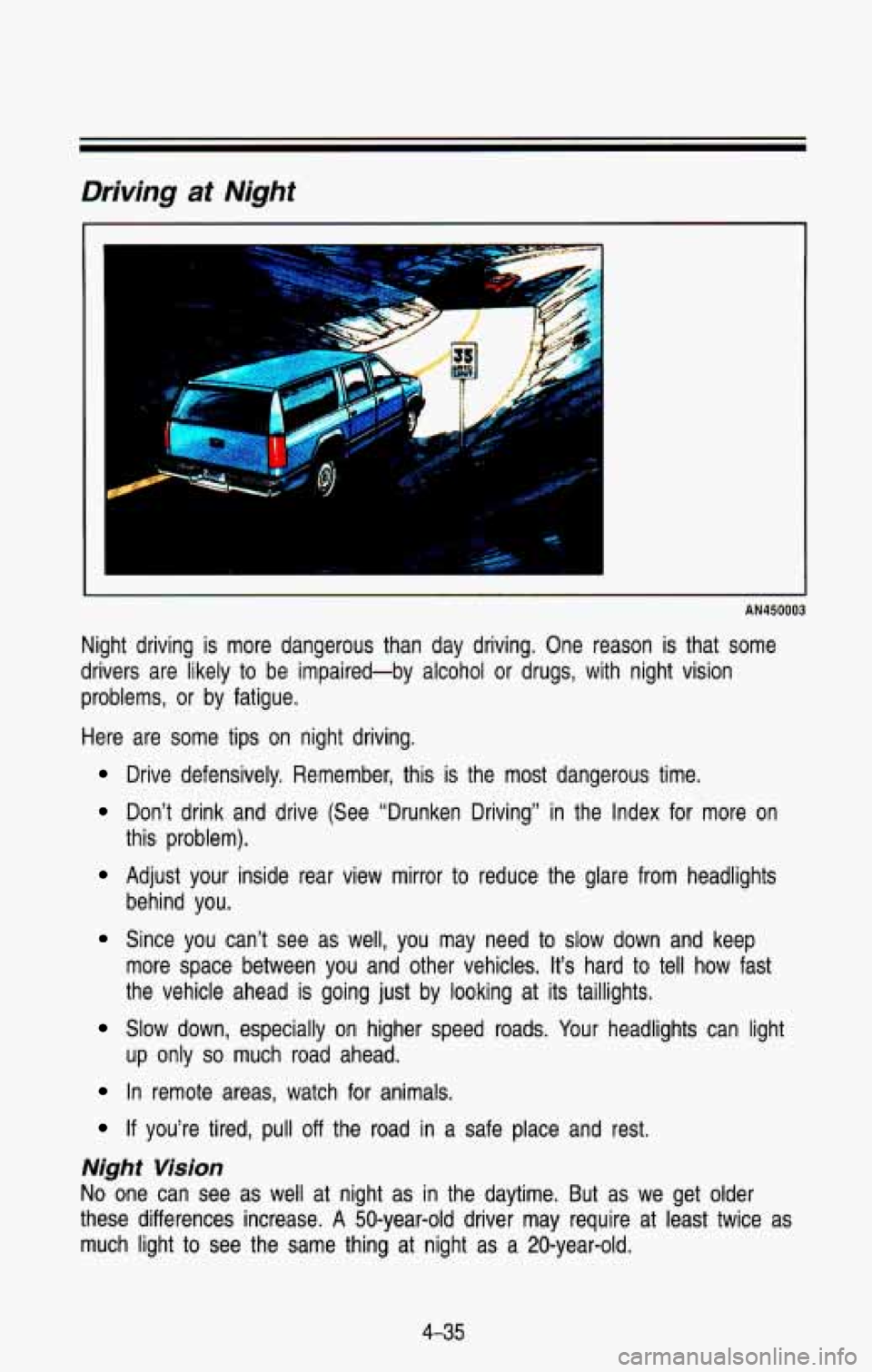
Driving at Night
me--===
AN450003
Night driving is more dangerous than day driving. One reason is that some
drivers are likely to be impaired-by alcohol
or drugs, with night vision
problems, or by fatigue.
Here are some tips on night driving.
Drive defensively. Remember, this is the most dangerous time.
Don’t drink and drive (See “Drunken Driving” in the Index for more on
this problem).
Adjust your inside rear view mirror to reduce the glare from \
headlights
behind you.
Since you can’t see as well, you may need to slow down and keep
more space between you and other vehicles. It’s hard to tell how fast
the vehicle ahead is going just by looking at its taillights.
Slow down, especially on higher speed roads. Your headlights can light
In remote areas, watch for animals.
up only
so much road ahead.
If you’re tired,
pull off the road in a safe place and rest.
Night Vision
No one can see as well at night as in the daytime. But as we get older
these differences increase.
A 50-year-old driver may require at least twice as
much light
to see the same thing at night as a 20-year-old.
4-35
Page 204 of 386
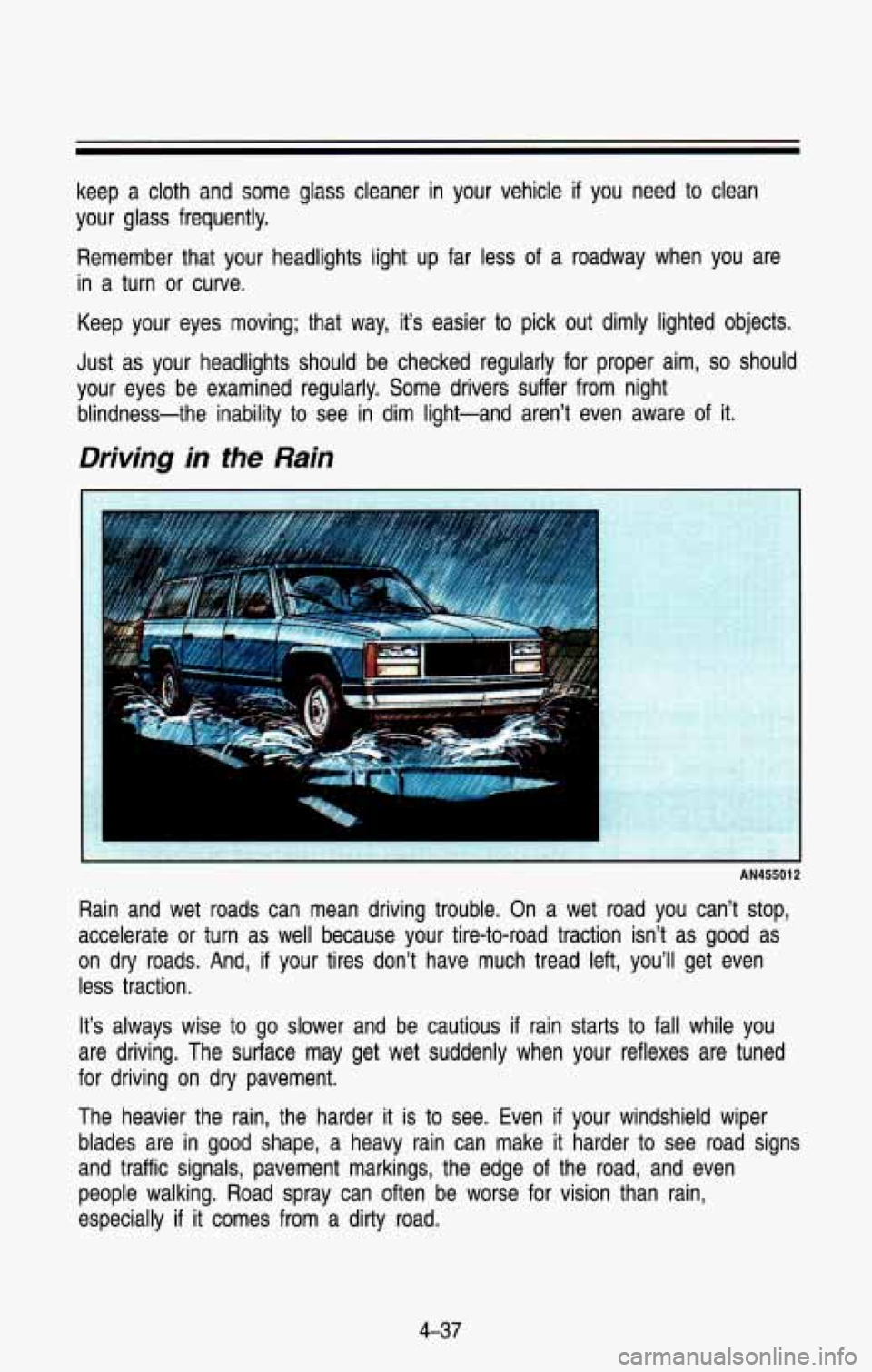
keep a cloth and some glass cleaner in your vehicle if you need to clean
your glass frequently.
Remember that your headlights light up far less of a roadway when you are
in a turn or curve.
Keep your eyes moving; that way, it’s easier to pick out dimly lighted objects.
Just as your headlights should be checked regularly for proper \
aim,
so should
your eyes be examined regularly. Some drivers suffer from night\
blindness-the inability to see in dim light-and aren’t even aware of it.
Driving in the Rain
AN455012
Rain and wet roads can mean driving trouble. On a wet road y\
ou can’t stop,
accelerate or turn as well because your tire-to-road traction isn’t as good as
on dry roads. And,
if your tires don’t have much tread left, you’ll get even
less traction.
It’s always wise to go slower and be cautious
if rain starts to fall while you
are driving. The surface may get wet suddenly when your reflex\
es are tuned
for driving on
dry pavement.
The heavier the rain, the harder it is to see. Even
if your windshield wiper
blades are in good shape, a heavy rain can make it harder to see road signs
and traffic signals, pavement markings, the edge of the road, and even
people walking. Road spray can often be worse for vision than rain,
especially
if it comes from a dirty road.
4-37
Page 206 of 386
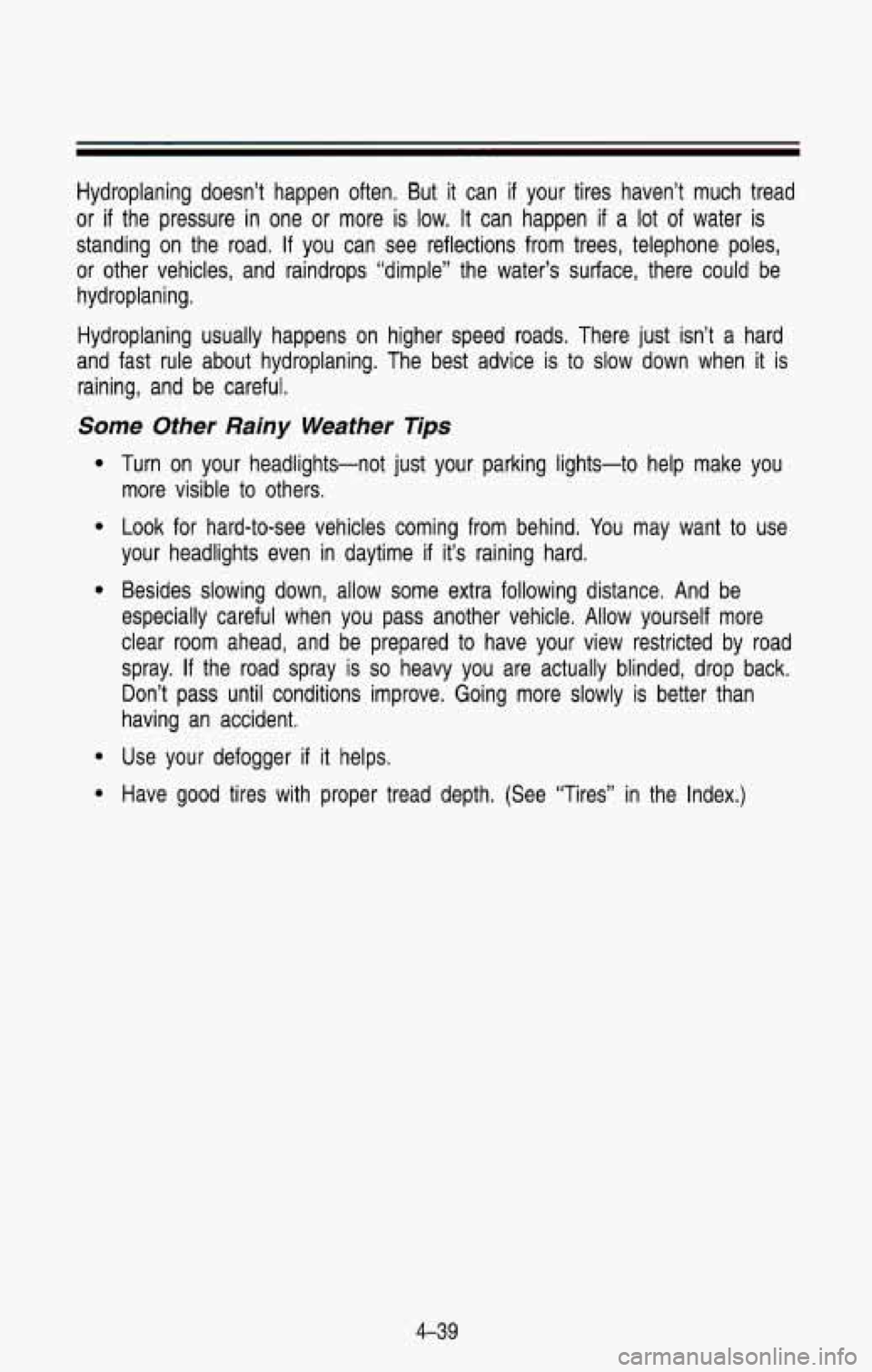
Hydroplaning doesn’t happen often. But it can if your tires haven’t much tread
or
if the pressure in one or more is low. It can happen if a lot of water is
standing on the road. If you can see reflections from trees, \
telephone poles, or other vehicles, and raindrops “dimple” the water’s s\
urface, there could be hydroplaning.
Hydroplaning usually happens on higher speed roads. There just isn’t a hard
and fast rule about hydroplaning. The best advice is to slow \
down when it is
raining, and be careful.
Some Other Rainy Weather Tips
Turn on your headlights-not just your parking lights-to help ma\
ke you
more visible to others.
Look for hard-to-see vehicles coming from behind. You may want to use
your headlights even in daytime
if it’s raining hard.
Besides slowing down, allow some extra following distance. And \
be
especially careful when you pass another vehicle. Allow yourself\
more
clear room ahead, and be prepared to have your view restricted\
by road spray.
If the road spray is so heavy you are actually blinded, drop back.
Don’t pass until conditions improve. Going more slowly is be\
tter than
having an accident.
Use your defogger
if it helps.
Have good tires with proper tread depth. (See “Tires” in\
the Index.)
4-39
Page 207 of 386
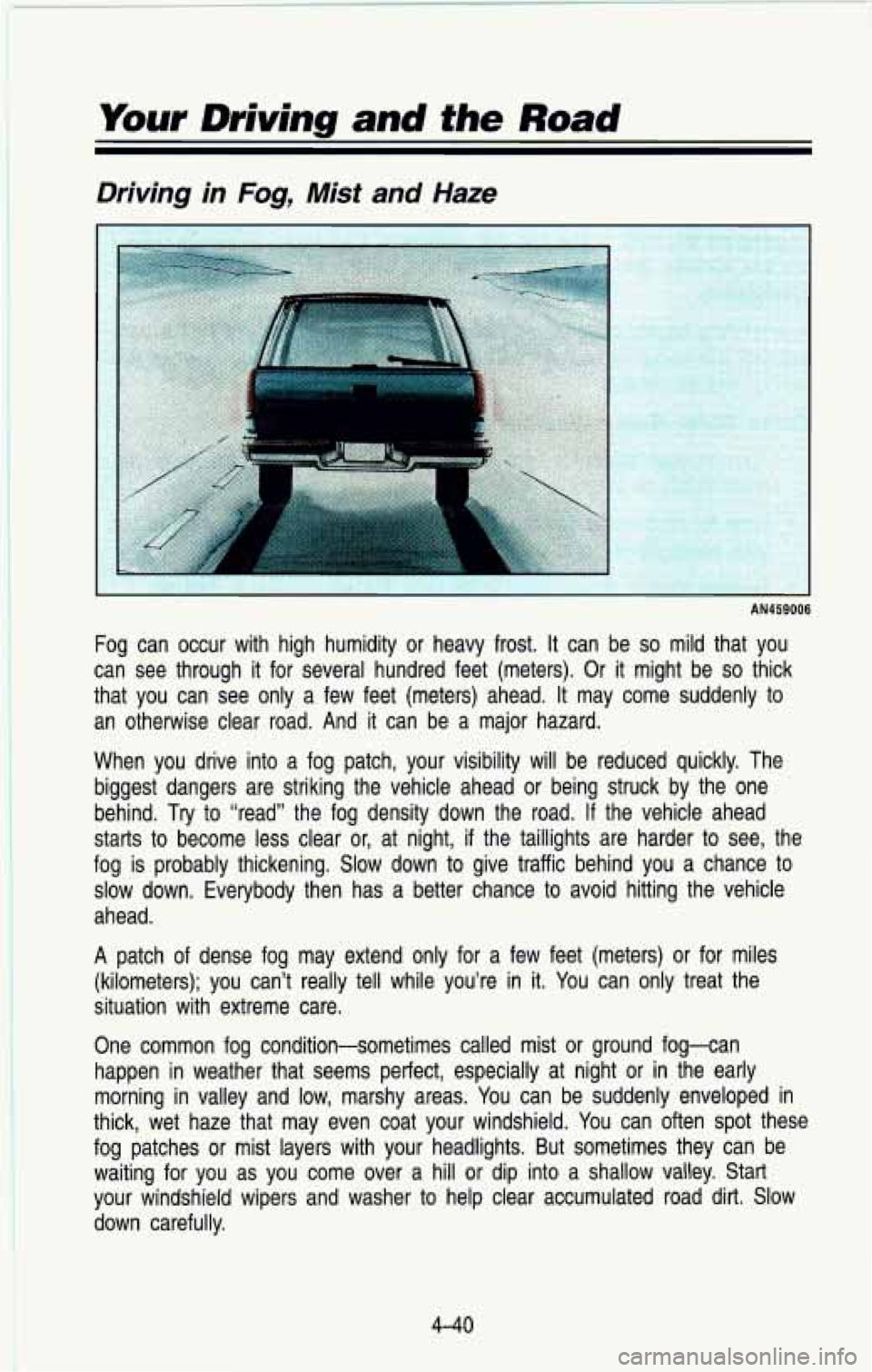
Your Driving and the Road
~~ ~
Driving in Fog, Mist and Haze
1
AN459006
Fog can occur with high humidity or heavy frost. It can be so mild that you
can see through it for several hundred feet (meters). Or
it might be so thick
that you can see only a few feet (meters) ahead. It may co\
me suddenly to
an otherwise clear road. And it can be a major hazard.
When you drive into a fog patch, your visibility will be redu\
ced quickly. The biggest dangers are striking the vehicle ahead or being struck \
by the one
behind. Try to “read” the fog density down the road. If the vehicle ahead
starts to become less clear
or, at night, if the taillights are harder to see, the
fog is probably thickening. Slow down to give traffic behind you a ch\
ance to
slow down. Everybody then has a better chance to avoid hitting the vehicle
ahead.
A patch of dense fog may extend only for a few feet (meters) or for miles
(kilometers); you can’t really tell while you’re in
it. You can only treat the
situation with extreme care.
One common fog condition-sometimes called mist or ground fog-can
happen in weather that seems perfect, especially at night or in the early
morning in valley and low, marshy areas. You can be suddenly enveloped in
thick, wet haze that may even coat your windshield. You can often sp\
ot these
fog patches
or mist layers with your headlights. But sometimes they can be
waiting for you as you come over a hill
or dip into a shallow valley. Start
your windshield wipers and washer to help clear accumulated road dir\
t. Slow
down carefully.
4-40
Page 208 of 386
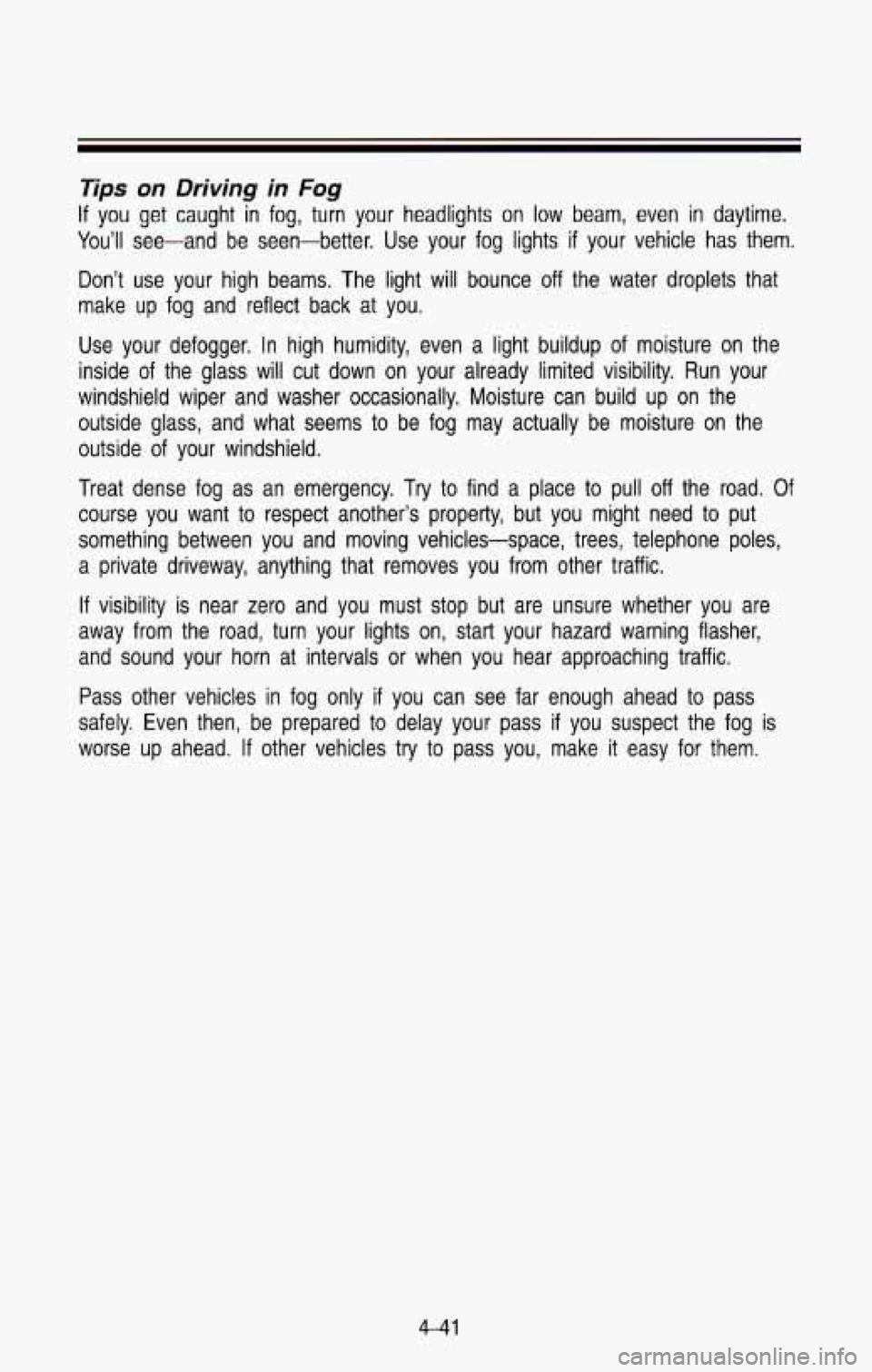
Tips
You’ll
If you
on Driving in Fog
get caught in fog, turn your headlights on low beam, even in daytime.
see-and be seen-better. Use your fog lights
if your vehicle has them.
Don’t use your high beams. The light will bounce
off the water droplets that
make up fog and reflect back at you.
Use your defogger. In high humidity, even
a light buildup of moisture on the
inside of the glass
will cut down on your already limited visibility. Run your
windshield wiper and washer occasionally. Moisture can build up \
on the
outside glass, and what seems to be fog may actually be moist\
ure on the
outside of your windshield.
Treat dense fog as an emergency. Try to find a place
to pull off the road. Of
course you want to respect another’s property, but you might\
need to put
something between you and moving vehicles-space, trees, telephone\
poles,
a private driveway, anything that removes you from other traffi\
c.
If visibility is near zero and you must stop but are unsure whet\
her you are
away from the road, turn your lights
on, start your hazard warning flasher,
and sound your horn at intervals or when you hear approaching \
traffic.
Pass other vehicles in fog only
if you can see far enough ahead to pass
safely. Even then, be prepared to delay your pass if you susp\
ect the fog is
worse up ahead.
If other vehicles try to pass you, make it easy for them.
4-41
Page 209 of 386
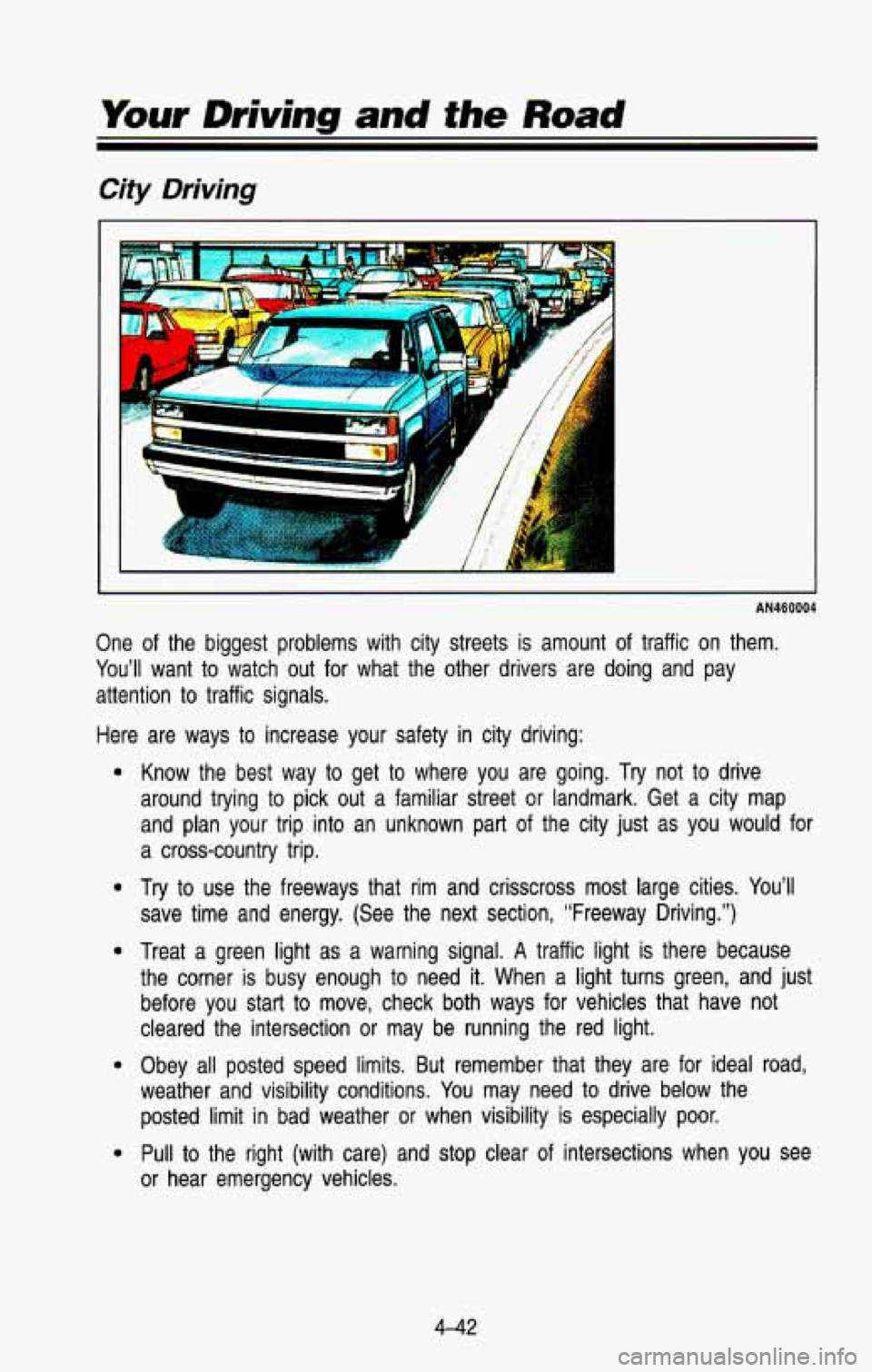
Your Driving and the Road
City Driving
AN460004
One of the biggest problems with city streets is amount of traffic on them.
You’ll want to watch out for what the other drivers are doing and pay
attention to traffic signals.
Here are ways to increase your safety in city driving:
e
e
e
e
Know the best way to get to where you are going. Try not to drive
around trying to pick out a familiar street or landmark. Get \
a city map
and plan your trip into an unknown part of the city just as you would for
a cross-country trip.
Try
to use the freeways that rim and crisscross most large cities. Yo\
u’ll
save time and energy. (See the next section, “Freeway Drivi\
ng.”)
Treat
a green light as a warning signal. A traffic light is there because
the corner
is busy enough to need it. When a light turns green, and just
before you start
to move, check both ways for vehicles that have not
cleared the intersection or may be running the red light.
Obey all posted speed limits.
But remember that they are for ideal road,
weather and visibility conditions. You may need to drive below the
posted limit in bad weather or when visibility is especially poor.
Pull to the right (with care) and stop clear
of intersections when you see
or hear emergency vehicles.
4-42